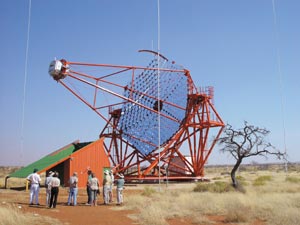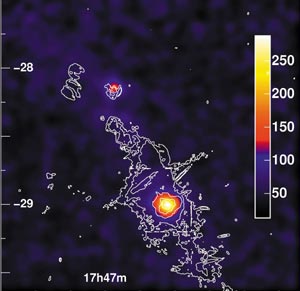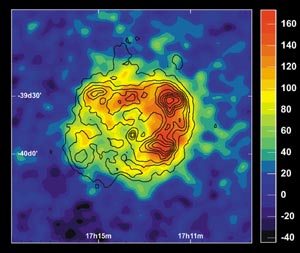The first results from the HESS array of Cherenkov telescopes are introducing a new era in the study of very-high-energy cosmic gamma rays, as Werner Hofmann describes.

On 28 September 2004 the four telescopes representing the first phase of the High Energy Stereoscopic System (HESS) were inaugurated by the Namibian Prime Minister Theo-Ben Gurirab. The event represented the culmination of a five-year construction and commissioning effort, carried out by physicists and technicians from 19 institutes in Germany, France, the UK, Ireland, the Czech Republic, Armenia, South Africa and Namibia.
The HESS telescopes measure cosmic gamma rays in the energy range above 100 GeV with unprecedented sensitivity and resolution. They achieve this by detecting the Cherenkov light that is emitted when a high-energy gamma ray is absorbed in our atmosphere, resulting in a cascade of electrons and positrons rushing through the air at speeds close to that of light. Viewed in its Cherenkov light, the cascade resembles the trail of a shooting star, pointing back to the origin of the primary gamma ray (figure 1a). However, the light is very faint – about 10 photons per square metre at a gamma-ray energy of 100 GeV – and the duration of the light flash is only a few nanoseconds. Large mirrors, fast photon detectors and short signal-integration times are required to collect enough light from the shower, with minimal contamination from night-sky background light.
The telescopes in the HESS array provide up to four different views of the same shower, which enable the direction of the gamma ray to be reconstructed to better than 0.1°, and its impact point can be located with a precision of 10-20 m. Knowing the distance from the telescope to the shower axis, the intensity of the Cherenkov image is converted into an energy estimate for the gamma ray, with a precision of about 15%. The requirement that multiple telescopes register a shower in coincidence virtually eliminates one major source of background – penetrating muons that hit the ground close to a telescope, resulting in Cherenkov rings like those seen in ring-imaging Cherenkov counters in particle-physics experiments (figure 1b).
The HESS telescopes are located in the scenic Khomas highland region of Namibia, within 20 km of the tropic of Capricorn, in an area cherished by professional and amateur astronomers for its clear and dark skies. Equally important, the southern location provides optimum views towards the central part of our galaxy, a region that hosts a variety of objects suspected to serve as cosmic particle accelerators. These include supernova remnants, pulsars, star associations with strong stellar winds, and of course the supermassive black hole at the very centre of our galaxy.
Indeed, one of the main goals of the HESS experiment is to identify positively sources of cosmic rays in the galaxy, ending a search that has been going on for almost 100 years, since the discovery in 1912 of cosmic rays by Victor Hess. Locating the origin of the abundant cosmic rays is so difficult because they are deflected in the interstellar magnetic fields; their arrival directions are uniformly distributed and give no clues concerning their origin. Real images of cosmic accelerators can be taken using very-high-energy (VHE) gamma rays, which are produced when the accelerated protons or electrons interact in or near their source with ambient material or – in the case of electrons – scatter off starlight or the cosmic microwave background radiation.

Just as the HESS collaboration encompasses particle physicists and astrophysicists, the HESS Cherenkov telescopes combine technologies from different fields. The design of the telescope structures and of the telescope mirrors – each segmented into 382 mirror facets with a combined area of 107 m2 – builds upon the experience collected in the design of low-cost solar concentrators. The mirrors are aluminized ground glass, manufactured like mirrors of astronomical telescopes, but with reduced requirements for optical quality. The focal-plane instrumentation – the “camera”, supported at 15 m focal length by a quadrupod attached to the telescope dish – contains 960 Photonis photomultiplier tubes (PMTs). PMT signals are sampled at a rate of 1 GHz by the analogue memory of the ASIC (application-specific integrated circuit) originally developed for the ANTARES neutrino detector. When an air shower is detected by several telescopes in coincidence, the signals are digitized, preprocessed and transmitted to a central computer cluster for recording. A novel feature of the HESS cameras is that the entire electronics is contained in the 1.5 x 1.5 x 1.5 m3 camera body, connected only by a few optical fibres.
While the last of the four HESS telescopes was completed in December 2003, data collection began in summer 2002 with the first telescope alone, and later with two and three telescopes. Even with a single telescope, HESS was the most sensitive instrument in the southern hemisphere. With four telescopes, gamma-ray sources with a flux below 1% of the flux from the Crab Nebula – which is often used as a standard candle of VHE gamma-ray astronomy – are routinely detected. For comparison, when the Whipple instrument discovered the Crab Nebula as the first tera-electron-volt gamma-ray source in 1989, a significant detection required about 50 hours of observation time; the HESS telescopes will detect such a source within 30 s!
It was no surprise therefore that the first HESS data taken during the construction and commissioning phase have already provided exciting results, many of which were presented at the International Symposium on High Energy Gamma-Ray Astronomy in Heidelberg, in July 2004. The active galaxy PKS 2155-304, detected previously only by the Durham Cherenkov telescope with a significance of about 6.8σ, exhibits a signal with more than 100σ, allowing for the first time an in-depth study of the emission and propagation of tera-electron-volt gamma rays for such a distant active galactic nucleus, at a redshift of z ≈ 0.12.

In HESS data taken towards the centre of our galaxy, a strong gamma-ray source stands out, coincident with Sagittarius A*, the supermassive black hole at the galactic core (Aharonian et al. 2004b). HESS can locate the source of the VHE radiation to within 30 arcseconds from the Galactic Centre, an order-of-magnitude improvement in precision compared with other instruments. The Galactic Centre has long been predicted as a source of VHE gamma rays generated in the accumulation and annihilation of dark-matter particles, for example the lightest stable supersymmetric particles. The characteristics of the gamma-ray signal detected by HESS are indeed consistent with the expected features for dark-matter annihilation, but would require very heavy (> 10 TeV) dark-matter particles and a large annihilation rate or enhanced density of the dark matter at the Galactic Centre. More conventional explanations include particle acceleration in the 10,000-year-old supernova remnant Sagittarius A East, which is still consistent with the HESS error circle for the source location. Future data should pin down the source location even better. Another key question is whether the gamma-ray flux is constant, or whether it varies, pointing to an origin near the Schwarzschild radius of the central black hole.

For the first time, a tera-electron-volt instrument is sensitive enough that several sources appear in the field of view. The field of the Galactic Centre shows, in addition to the strong source close to Sagittarius A*, a second source, which appears to be associated with the pulsar nebula inside the supernova remnant G0.9+0.1. Similarly, observations targeted at the pulsar PSR B1259-63 have revealed – besides a gamma-ray signal from the pulsar – evidence of a second source about 0.6° north of the pulsar. This source HESS J1303-631 could not so far be associated with a counterpart in other wavelength regimes and may represent a type of cosmic accelerator hitherto unknown.

The most exciting of the first results from HESS is the image of the supernova RX J1713.7-3946, which shows a ring of twice the size of the Moon glowing in tera-electron-volt gamma rays (figure 3). Gamma-ray emission from this remnant was detected before with the CANGAROO instrument, but only HESS, with its high sensitivity and angular resolution, could actually resolve the supernova shell as the source of the radiation. This image provides the unequivocal proof that supernova shocks can accelerate particles to multi-tera-electron-volt energies. The measured energy spectrum of gamma rays extends to beyond 10 TeV and exhibits a power-law energy dependence with a spectral index of 2.2±0.2, consistent with predictions of theories for the shock acceleration of cosmic rays (Aharonian et al. 2004b).
To demonstrate fully that the gamma rays result from interactions of accelerated cosmic-ray protons – as opposed to processes involving high-energy electrons (of which the signature is evident in the strong synchrotron X-ray emission of the supernova shell) – will require more detailed studies of the morphology and wide-band spectra of the remnant.
These first results from HESS illustrate the power of the new generation of Cherenkov instruments, which include CANGAROO III, MAGIC and VERITAS. Tera-electron-volt gamma-ray astronomy has finally entered a stage where sources are no longer featureless points in the sky. Instruments have achieved the sensitivity to reach beyond the few exceptionally strong sources, and provide images of a new tera-electron-volt sky.
• For more information see www.mpi-hd.mpg.de/HESS.
Further reading
F Aharonian et al. 2004a Astron. Astrophys. 425 L13.
F A Aharonian et al. 2004b Nature 432 75.
T N LaRosa et al. 2000 AJ 119 207.
Author:
Werner Hofmann, MPI für Kernphysik, Heidelberg.








